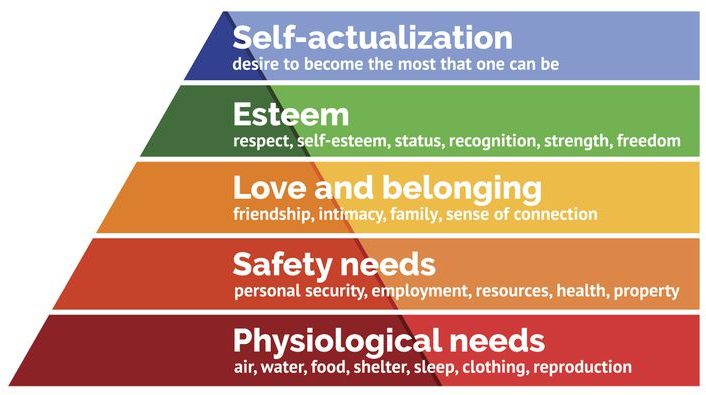Climbing the rungs of the ladder
Abraham Maslow was an American psychologist who created Maslow’s hierarchy of needs. It describes a set of needs where until you satisfy a base need, you typically will not have success satisfying the higher level needs.
To help people get to a level that they can afford to be charitable, we need to work through their hierarchy of needs. Because there are many organizations fulfilling these needs effectively, we chose to work with them as they have perfected the delivery of these services.

We will work from the bottom, we will get the first two layers satisfied before we begin our charitable works.
Those will be Physical and Safety needs.
Those will provide the stability in your life to begin the journey to making a better world.
Physiological (Physical) Needs

So here is where you start.
We will first assume, that you are about to leave home, although if you are starting from zero we will talk about that after establishing these goals
- Shelter
You need a place to stay. At this stage if you have a job that pays any kind of minimum wage you will need to find a place with room-mates to split the bills. Splitting an apartment with 2 or 3 room-mates is a good place to start. - Food
You might have been used to 3 meals a day, but honestly that is not going to happen for a while. Plan on getting one good sized meal a day and maybe a snack. Many people find that working at a fast food restaurant can get you fed at a pretty cheap price that is offered to employees while you get started. - Clothing
People will judge you by your appearance, and clothing can be an important part of that. Surprisingly, it is not important to have expensive clothing, but is is important to have clothing that is not worn and is clean.
Obviously sleep and reproduction are a part of this as well, but I think you can probably work that out for your self!
SHELTER
Starting out you will end up with a low priced apartment shared with room-mates. It will not be luxurious, but you should be able to find something clean and safe if you can get a minimum wage job. You will get good room-mates and sometimes you will get bad ones. Try and use your best judgment. Realize you might have to move if you get a really bad room-mate.
First, look for a room-mate. Web sites like:
https://www.roomies.com/madison-wi
https://roomster.com/roommates/wisconsin/madison
https://madison.craigslist.org/search/roo#search=1~gallery~0~0
will get you in contact with potential room-mates. Don’t forget that you have friends! Go to the library and use Google to search for them with the criteria apartment roomates in madison, wi
https://www.google.com/search?client=firefox-b-1-lm&q=apartment+roomates+in+madison%2C+wi
Second look for apartments out of major metropolitan areas. The suburbs and rural areas will have rental rates that are sometimes half of what you find in the down-town. Get a list of them and go over them with your potential room-mate.
Use websites like these to search the suburbs:
https://www.zillow.com/madison-wi/apartments/
https://www.apartments.com/madison-wi/
https://www.madisonapartmentliving.com/search.j
https://www.trulia.com/for_rent/Madison,WI/
FOOD
Getting food is not always easy, but it has been well over a hundred years since anyone has starved to death in this country.
How to get food If you have money.
If you have any money at all, you can probably feed yourself. Dining out will be out of the question, so preparing your own foods will be the way to make you money last longest. This list is in order from least expensive to most expensive. Many will limit the number of times per week that you may take food from them.
Food Pantries
Food pantries are often available in metropolitan areas. Most have limited hours, so use a library computer to confirm the hours before traveling there. Some of the pantries will require pr-registration before you can access their resources. You can use a computer at the library to pre-register. They will want to know how many people are being fed.
Groceries
When you first start out, you won’t be eating steaks every night! To live on the cheapest foods, focus on pantry staples like rice, pasta, beans, and oats, which are often very affordable and versatile. Also, consider fruits and vegetables that are in season, as well as frozen vegetables, which can be cheaper than fresh. Plan your meals so that you can use leftovers for subsequent meals. Eggs are a good source of protein that can be cooked in various ways.
Frozen Breakfast Burritos are a quick and easy breakfast option. Peanut Butter is a protein-rich spread that can be added to sandwiches, fruits, or other dishes.
Convenience Store Prepared Meals
Sometimes a convenience store like KWIK Trip will sell prepackaged meals at a cheap price. The trick is to only eat ONE!.
Fast Food
Not the healthiest or the cheapest, but for the cheapest fast food options, Taco Bell stands out with its Cravings Box and Value Menu, and soft/crunchy meat tacos for cheap. Wendy’s also provides value with its Biggie Bag, including a sandwich, four-piece chicken nuggets, fries, and a drink. Sonic has a value menu with items like a junior burger and chicken tender wraps. Again, the trick with these is only eat ONE!
Restaurants
One word…..DON’T. If you are just starting out, this is a stupid way to eat. You pay premium money for ‘atmosphere’ which certainly is not filling your stomach. Just DON’T DO IT.
CLOTHING
You need basic clothing. Things you wear every day casually. This clothing should have the following characteristics so that you only throw them away when they wear out, and not when they go out of fashion.
Although you would not know it, people will judge you on your appearance and the clothing you wear.
- Clothing has Solid Colors. No patterns to mismatch or fall out of fashion.
- Clothing without advertising on it.
- Shirts must have a collar
- Working jeans are dark denim so stains don’t easily show.
- Heavy Coats can be bought that are made of denim.
- Shoes…. 1 pair of sneakers, brown boots
- Dress socks. All Black so you don’t have to match them.
- Sneaker Socks. All White for the same reason.
Mens Sample Casual Clothing List. - 2 Polo Shirts
- 2 Oxford Button up shirts
- 2 Pair of Chino Trousers
- 2 Pair of Denim Trousers
- White t-Shirts to wear beneath shirt to make them last longer
- Under garments
- 4 pairs of black socks
- 4 pairs of white socks
- Light Jacket (not a hoodie)
- Heavy Jacket
- Plain mid-brown belt
Womens Sample Casual Clothing List (in progress) - Instead of skinny jeans or flared jeans, buy slim chinos or tapered trousers.
- Get some fitted boatneck knits and tuckable blouses in place of tanks and tees.
- Instead of an a-line mini, buy an a-line midi. Instead of hoodies, buy cardigans.
- cardigans in a few different shades like black, navy, and gray. Underneath, you can switch out different t-shirts or tops.
- Smooth Full Coverage Bra
- Seamless Panties
- Little Black Dress
- White Button-Up Shirt
- Denim or Chambray Button-Up Shirt
- Knee-Length Skirt
- Nude Heels or Flats stay away from things like athletic sneakers, flip flops, sandals, and open-toe shoes.
- a blazer, sweater jacket, or denim jacket if you’re wearing something smart underneath. Stay away from hoodies, athletic jackets, and parkas.
